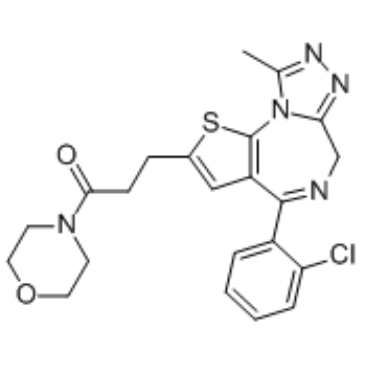105219-56-5
| Name | Apafant |
|---|---|
| Synonyms |
3-[4-(2-Chlorophenyl)-9-methyl-6H-thieno[3,2-f][1,2,4]triazolo[4,3-a][1,4]diazepin-2-yl]-1-(morpholin-4-yl)propan-1-one
1-Propanone, 3-[4-(2-chlorophenyl)-9-methyl-6H-thieno[3,2-f][1,2,4]triazolo[4,3-a][1,4]diazepin-2-yl]-1-(4-morpholinyl)- 4-[3-[4-(2-chlorophenyl)-9-methyl-6h-thieno[3,2-f][1,2,4]triazolo[4,3-a][1,4]diazepin-2-yl]-1-oxopropyl]morpholine Apafant 3-[4-(2-Chlorophenyl)-9-methyl-6H-thieno[3,2-f][1,2,4]triazolo[4,3-a][1,4]diazepin-2-yl]-1-(4-morpholinyl)-1-propanone |
| Description | Apafant (WEB 2086), a potent platelet-activating factor (PAF) antagonist, inhibits PAF binding to human PAF receptors with a Ki of 9.9 nM[1]. |
|---|---|
| Related Catalog | |
| Target |
Ki: 9.9 nM (Platelet-activating factor)[1] |
| References |
| Density | 1.5±0.1 g/cm3 |
|---|---|
| Boiling Point | 720.2±70.0 °C at 760 mmHg |
| Melting Point | 186-188ºC |
| Molecular Formula | C22H22ClN5O2S |
| Molecular Weight | 455.96 |
| Flash Point | 389.4±35.7 °C |
| Exact Mass | 455.118286 |
| PSA | 100.85000 |
| LogP | 1.32 |
| Vapour Pressure | 0.0±2.3 mmHg at 25°C |
| Index of Refraction | 1.734 |
| Storage condition | 2-8°C |
CHEMICAL IDENTIFICATION
HEALTH HAZARD DATAACUTE TOXICITY DATA
|
| Hazard Codes | Xn |
|---|---|
| RIDADR | NONH for all modes of transport |
